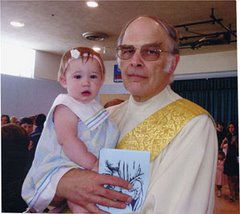Mark 9:2-10
I think we all have moments when we
catch a glimpse of glory. It's usually characterized by what seems
to be an interruption in the flow of our thoughts; our monkey minds,
as the Buddhists describe the mind, suddenly becomes still and takes
a minute to re-boot.
One of the moments I remember, and you
know I always tell the truth, was when I first saw my wife in her
wedding dress. She appeared in the back of the church and came up
the aisle to me on the arm of her father. I couldn't catch my
breath. I had no words. I always thought she was beautiful, but
this vision … I beheld glory. And of course it passed in a moment,
and I returned to my nervous self, worried that I would trip or
forget my lines or otherwise make a fool of myself.
Maybe you've had such experiences. If
you are a fan of flowers, like I am, sometimes looking at a flower
can trigger that momentary response – I am beholding glory. Who
else but human beings can appreciate flowers? Mammals can't; most
cannot see color. Birds, who can see color, are designed to pay
attention to moving things, not something sitting there like a
flower. And you go further down the chain of life and there is
nothing in the brain to stop and appreciate something like a flower.
I think the very fact of flowers is proof that God exists and likes
to please us.
Some people appreciate music. I must
say that I'm not into music. I tried for a long time to appreciate
the classics, and while I can listen with pleasure, I am not moved to
transcendence – but I know people who are. I know a man who used
to go to Budapest whenever he could save up the money just to listen
to opera. He was beholding glory.
We can behold glory in nature, in
human art, in someone we love, perhaps, but there are people who
behold glory in their religious life. We call them mystics. One
characteristic of a mystic is that they haven't got time to explain
to you what is happening; they are too busy pursuing more of it.
Maybe being a mystic is genetic; I take consolation in knowing that
Mother Theresa had about as much mystical experience as I've had.
I'll never be a Saint Francis or Padre Pio, and I'm okay with that.
When I think about the transfiguration
of Jesus, I have a lot of questions. Some are trivial, like how did
the apostles know that Jesus was talking to Elijah and Moses? They
didn't have photographs in those days. Maybe name badges? But the
apostles most likely couldn't read. More seriously, though, why?
Was it so that they would really pay attention after God himself said
to listen to Jesus? I think the answer is no – the apostles leave
the mountain wondering what it all means, just like before. Was it
so that they would have something to remember, something to hang on
to, as they watched Jesus being tortured and crucified? Maybe, but
then I wonder why Jesus didn't take the other apostles along. The
ones like Andrew and Philip and Matthew remained just as faithful as
Peter, James and John, and they hadn't even heard about the
transfiguration, let alone witnessed it. And I don't think this was
a theophany – a moment when the veil is lifted and you realize
Jesus is actually God. Jesus, after all was fully human, so whatever
happened on that mountain was a fully human event, and maybe that's
the point.
What the apostles beheld when Jesus
appeared in dazzling white, radiating light, speaking to Elijah and
Moses, long dead, was a vision of how human beings were meant to be.
No limits of time or space, bodies of fire, not mud; and most of all,
beloved, beloved by the father. The apostles beheld glory, the glory
that is a human being fully alive, a human being the way we are meant
to be, the way we will be some day, God willing.
Is that far-fetched? Am I stretching
the story too much? In the book of Revelation, it says that those
who have undergone the tribulation have washed their robes in the
blood of the lamb and they have become white as snow. The book of
Daniel describes those who are wise – the people who have chosen to
follow God's law – as shining like the heavens and those who lead
many to justice will shine as stars for all eternity. And the book
of Revelation describes the woman clothed with the sun, with the moon
at her feet, with a crown of twelve stars around her head. And many
think this refers to Mary, who we believe has gone before us and is
experiencing now what will be our future.
The apostles accompanied Jesus back
down the mountain. They ponder what they have witnessed and wonder
what it all means. They see Jesus dying on the cross, broken,
bloody, in pain and agony. They will witness his resurrection. And
as time goes on perhaps they began to see that every human being
shares the divine spark that was revealed in Jesus.
Now there are certainly other ways of
seeing the transfiguration. But here we are in the second Sunday of
Lent, and those of us who have given something up for lent or taken
on a lenten practice like daily mass, scripture reading, or some sort
of regular prayer are faltering a bit. We say, this first week was
hard. How am I going to get through the next five weeks? And we
struggle with our human nature.
But we are reminded in the story of
the transfiguration who we are really meant to be, what Jesus our
older brother has in store for us. And that should give us strength
to persevere, not only in keeping our lenten promises, but in
everything we undertake as Christians. And as we realize oir own
potential we can't help but begin to see each other transfigured.
There is an ancient saying which is appropriate: Man is the mirror in
which God sees himself. And just for a moment, on the mountain of
the transfiguration, the apostles were given the privilege of seeing
what God sees when he looks at one of his children.



































